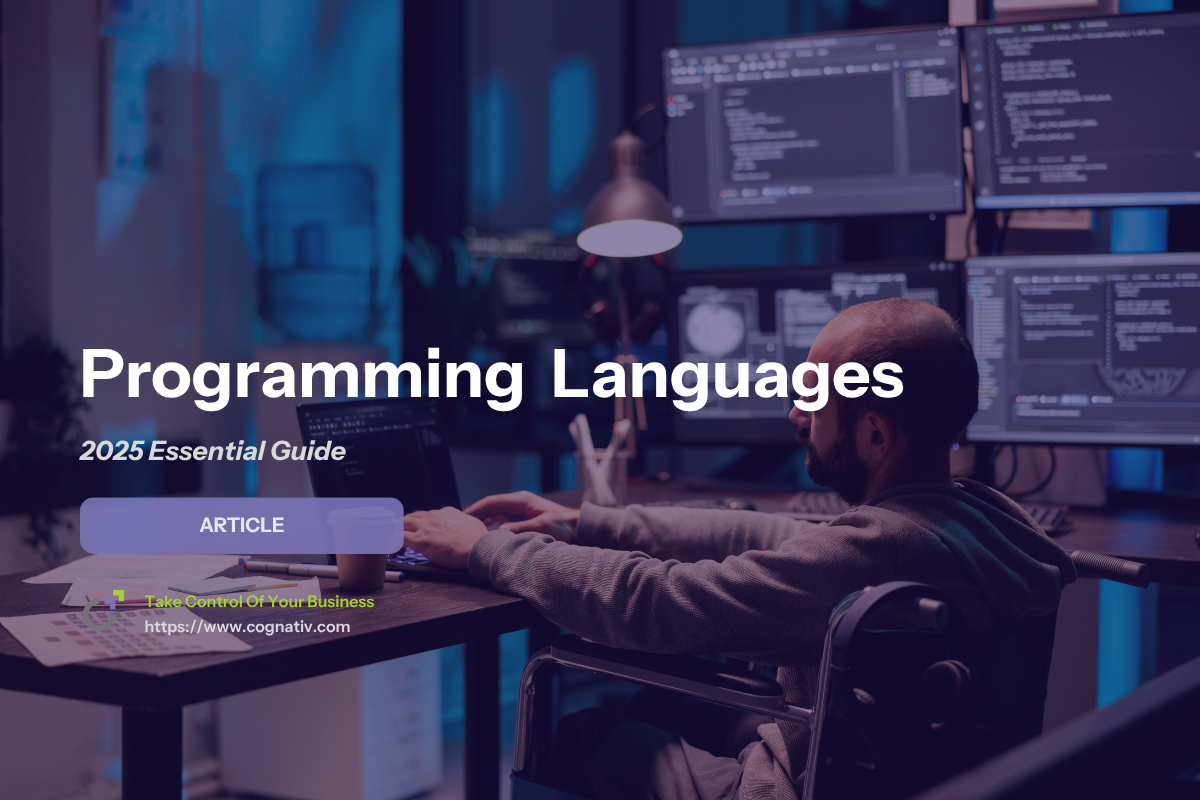Top Technologies Programming Languages in 2025: Essential Guide
Wondering which programming languages you should focus on for future-proofing your skills? This article covers the top programming languages in 2025. We’ll dive into emerging languages like Crystal, Red, and Pony, as well as the most popular ones like Python and JavaScript. Discover the languages that will shape the future of technologies programming.
Cloud computing is a key area where these languages are applied, providing scalable resources, infrastructure, and services essential for modern software development.
Key Takeaways
-
Emerging programming languages like Crystal, Red, and Pony are gaining popularity in 2025 for their unique strengths in performance, flexibility, and concurrent processing.
-
Established languages such as Python, JavaScript, and Rust continue to dominate due to their versatility, safety, and adaptability for various applications, including web development and data science, as well as their scalability and integration capabilities in enterprise environments.
-
Specialized languages like Solidity, Lua, and VHDL serve specific technological needs, such as blockchain development, game scripting, and hardware design.
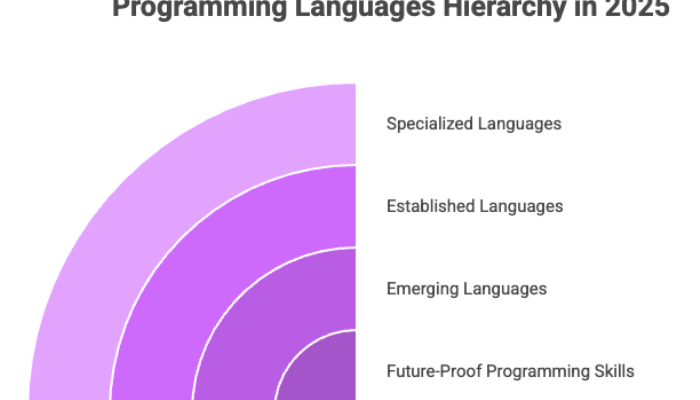

Introduction to Programming
Programming is at the heart of software development, enabling individuals and teams to create software applications that power everything from mobile devices to enterprise systems. The process of programming involves several key steps: defining the problem to be solved, designing an effective solution, writing the source code, and then rigorously testing and maintaining that code over time.
Successful programming requires not only technical skills but also a solid understanding of computer science concepts, algorithms, and the principles that guide modern software development. By mastering these fundamentals, developers can efficiently write code that is reliable, scalable, and adaptable to new challenges in the ever-evolving world of technology.
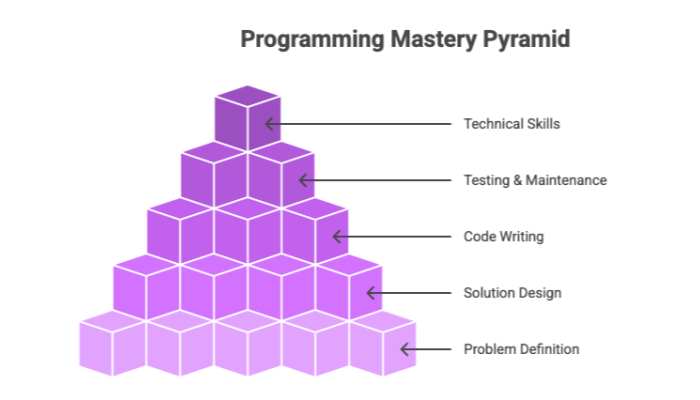
What are Programming Languages?
Programming languages are the essential tools that allow developers to communicate instructions to computers. A programming language is a formal system of syntax and rules that enables the creation of computer programs, which can perform a wide range of tasks.
There are several types of programming languages, each suited to different aspects of software development. High-level programming languages, such as Python and Java, are designed to be easy to read and write, making them accessible for both beginners and experienced developers.
Low-level languages, like Assembly, provide more direct control over hardware, which is crucial for performance-critical applications. Scripting languages, including JavaScript and PHP, are widely used for web development and server-side scripting, allowing developers to build dynamic web pages and interactive web applications. By choosing the right programming language for a given project, developers can optimize productivity and achieve their software goals more effectively.
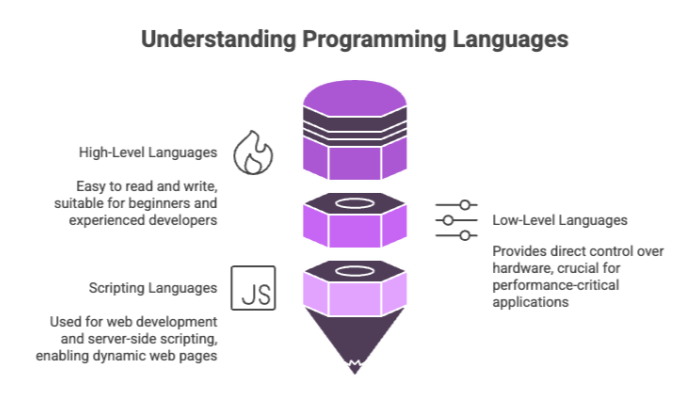
Programming Language Classification
Programming languages can be grouped according to the programming paradigms they support, which influence how developers structure and organize their code. Object oriented programming languages, such as Java and C++, focus on organizing code into objects that encapsulate both data and the functions that operate on that data. This approach promotes modularity and code reuse, making it easier to manage complex software systems.
Functional programming languages, like Haskell and Lisp, emphasize the use of pure functions and immutable data structures, which can lead to more predictable and reliable software. Procedural programming languages, such as C and Pascal, organize code into procedures or functions that perform specific tasks, following a step-by-step approach to problem-solving. Understanding these classifications helps developers select the most appropriate programming languages and paradigms for their projects, whether they are building robust data structures, developing new software applications, or exploring innovative programming techniques.
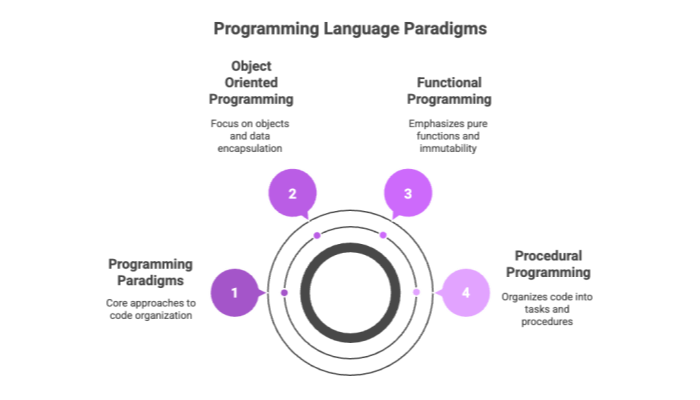

Programming Paradigms
A programming paradigm is a fundamental approach to structuring and writing software, shaping the way developers think about and solve problems. Each paradigm offers a unique perspective on organizing code, with its own set of principles, strengths, and trade-offs. By understanding different programming paradigms, developers can choose the best approach for their specific project requirements and leverage the full potential of modern programming languages.
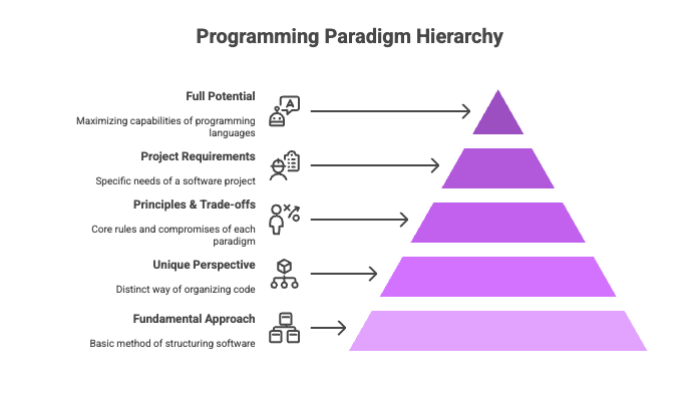
Object Oriented Programming
Object oriented programming (OOP) is a widely used paradigm in software development that structures code around objects—self-contained units that combine data and the functions that operate on that data. OOP is built on key principles such as encapsulation, which hides the internal state of objects; inheritance, which allows new objects to build upon existing ones; and polymorphism, which enables objects to be treated as instances of their parent class. These principles help developers create modular, reusable, and maintainable code, making OOP a popular choice for building complex software applications.
Many of the most popular programming languages, including Java, C++, and Python, support object oriented programming, making it a cornerstone of web development, game development, and enterprise software. By leveraging OOP, developers can efficiently model real-world systems, promote code reuse, and streamline the development process for a wide range of software technologies.
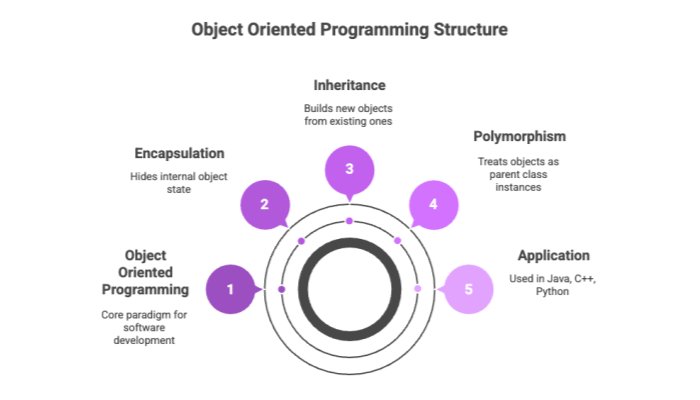

Emerging Programming Languages
Emerging programming languages drive innovation in the fast-paced world of software development. These languages are crafted to meet the demands of new technologies and applications, offering software developers enhanced performance, efficiency, and flexibility. In 2025, languages like Crystal, Red, and Pony lead the charge, each with unique strengths and applications.These languages represent a shift towards more specialized language and powerful tools that cater to specific needs in software development, including those designed for embedded applications, which are crucial in embedded systems development. We will explore what makes these exciting new compiled languages stand out in the crowded field of other contemporary languages.
Crystal
Inspired by Ruby, Crystal combines speed and efficiency, making waves in the programming community. This programming language offers a Ruby-like syntax, which makes it accessible to developers who appreciate Ruby’s elegance but need faster execution times. Crystal offers the best of both worlds—intuitive syntax and high performance.
Crystal’s fast compilation times are particularly beneficial for web development and performance-intensive services. Crystal provides the robustness and speed required for efficient and scalable solutions, whether for web applications or complex computational tasks.
Red
Red stands out for its versatility, catering to both high-level and low-level programming needs. Red’s flexibility makes it a powerful tool for a wide range of applications, from embedded programming to graphical applications. Red allows developers to define data types, which helps organize data structures and operations, supporting modular and reusable code. Red’s simple syntax makes it ideal for rapid prototyping and development, allowing developers to create applications with ease in an integrated development environment.
Red bridges the gap between high-level abstractions and low-level control. This dual capability enables developers to build sophisticated software systems while maintaining control over performance-critical aspects of their applications.
Pony
Designed for high-performance, concurrent applications, Pony is a standout choice for building reliable and efficient software. Pony’s memory safety ensures applications run smoothly without unexpected crashes. This is achieved through an innovative type system that rigorously checks variables and efficient memory management.
Pony’s actor-based model for managing processes further enhances its reliability and performance. This model allows developers to create highly concurrent applications that can efficiently handle multiple tasks simultaneously, making Pony an excellent choice for building scalable and responsive software systems.
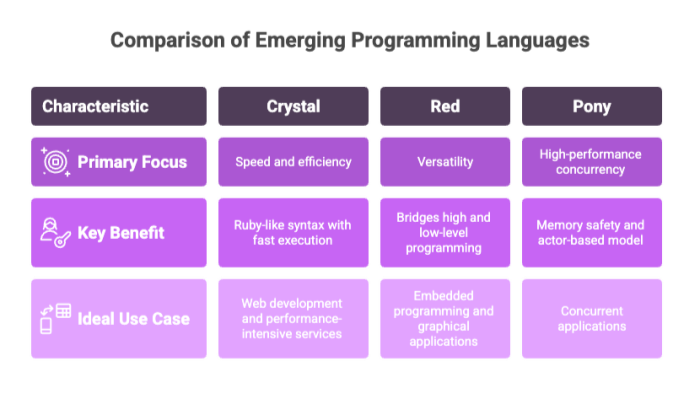

Popular Programming Languages in 2025
In 2025, certain programming languages continue to dominate due to their widespread adoption and versatile applications. These popular programming languages have proven their mettle in various domains, from web development to systems programming to desktop applications. The most popular programming language includes:
-
Python, known for its simplicity and readability
-
JavaScript, essential for web development and interactive applications
-
Rust, praised for its performance and memory safety
Each language brings unique strengths to the table. Their rising popularity reflects the evolving needs of developers and the growing complexity of software systems. We will examine why these widely adopted popular language choices are the most popular choices in 2025.
Python
Python’s popularity has surged, making it the leading language for AI, data science, and web development. In fact, Python is often the primary language chosen for these domains. Its high-level nature and emphasis on readability and simplicity make it accessible for beginners while remaining powerful for experienced developers.
The versatility of Python is one of its greatest strengths. It is commonly used in data analysis, scripting, scientific research, web app development, and AI applications. Extensive libraries like TensorFlow and Django support Python’s wide range of applications, making it a top choice across various fields.
Python’s combination of readability, versatility, and extensive support libraries solidifies its position as a popular programming language in 2025. Whether you’re building complex algorithms or simple scripts, Python provides the tools needed to succeed.
JavaScript
JavaScript remains a cornerstone of web development, powering 98% of websites globally. Its primary use extends beyond the browser to include mobile app development, server applications, and even games. JavaScript’s ability to facilitate dynamic and interactive web elements makes it indispensable for creating modern user experiences.
JavaScript’s server-side capabilities, especially through Node.js, have expanded its use in multi-user communication and real-time applications. This versatility allows developers to use JavaScript across the entire stack, from the front end to the back end.
JavaScript’s features for web developers, such as dynamic elements and interactive web applications, ensure its continued relevance and popularity in 2025. As a scripting language, it enables developers to create responsive and engaging web applications that meet the demands of today’s digital landscape.
Rust
Rust has carved out a niche for itself by focusing on safety and performance, making it ideal for secure software and efficient applications. Its robust memory management and concurrency capabilities set it apart from other programming languages, ensuring that applications run smoothly and securely.
Rust’s compiler strictly checks variables and memory addresses, helping prevent errors and enhance security. This makes Rust a preferred choice for systems programming and applications that require a high degree of reliability. Rust excels in system programming, making it well-suited for developing operating systems, embedded systems, and handling low-level hardware interactions where efficiency and direct hardware access are crucial.
Rust’s applications span game engines, operating systems, browser components, and file systems, showcasing its versatility and power. For developers looking to build high-performance, secure applications, Rust provides the tools and features needed to succeed.
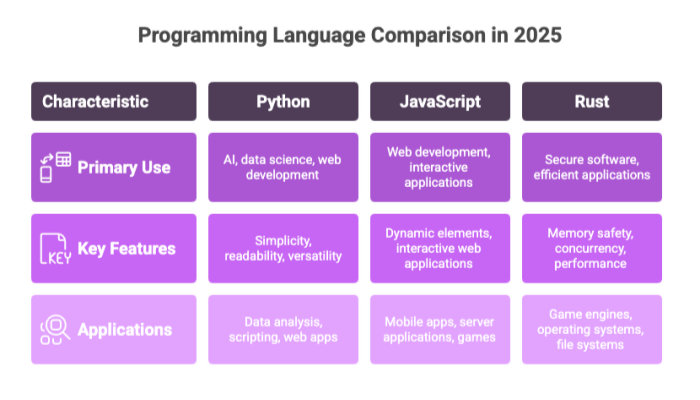

Functional Programming Languages
Functional programming languages emphasize immutability and higher-order functions, offering a different approach to software development that enhances reliability and reduces bugs. Functional programming has significantly influenced programming language design, especially by promoting immutability and higher-order functions as core principles. These languages are particularly suited for applications where safety and predictability are paramount in a functional language object oriented language designed for such purposes.Haskell, Elixir, and F# are gaining traction as developers seek new ways to write code that is safer and more efficient. We will explore these languages to understand their unique characteristics and applications.
Haskell
Haskell stands out as a purely functional programming language and a high level programming language emphasizing immutability and lazy evaluation. This approach ensures that functions depend solely on their arguments, leading to more predictable and reliable code.
Though primarily used in academic settings, Haskell’s applications in various industries are growing. Haskell offers a robust platform for developers exploring functional programming, providing opportunities to learn and innovate.
Elixir
Elixir excels in building scalable and efficient real-time applications, popular in sectors like messaging, finance, and IoT. Its scalability and efficiency are key factors that drive its adoption in these fields. The language’s ability to handle distributed systems with ease further enhances its appeal.
Elixir provides the tools for developers needing real-time processing and high scalability.
F#
F# is a functional-first programming language designed for the .NET framework, offering a concise syntax and interoperability with other .NET languages. Its applications in data science, finance, and enterprise programming make it a versatile tool for developers in these fields.
F# combines functional programming features with integration into the .NET ecosystem, creating a powerful platform for complex software solutions. For developers looking to leverage functional programming within a well-established framework, F# is an excellent choice.
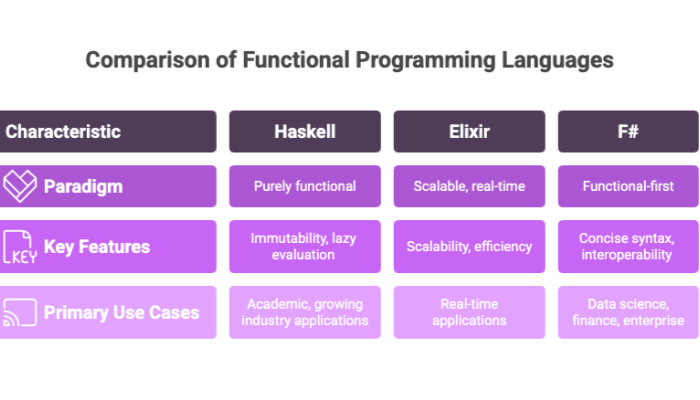

Programming Languages for Web Development
Web development remains dynamic and rapidly evolving, with programming languages playing a crucial role in the development process of creating interactive and responsive dynamic web pages and web applications. Languages like TypeScript, PHP, and Dart are at the forefront of front end web development, and structured query language (SQL) is an essential tool for managing and interacting with databases in web development, each offering unique advantages for web developers.These languages are crucial for building modern web applications that meet today’s user demands. We will explore the specifics of these languages to understand their roles in web development.
TypeScript
TypeScript, a superset of JavaScript, adds optional static typing and supports static and dynamic typing, catching errors during development and improving code quality. This feature makes TypeScript particularly beneficial for large-scale projects where maintaining code quality is crucial.
The language’s integration with JavaScript allows developers to gradually adopt TypeScript in their projects, making it a flexible and powerful tool for modern web development. TypeScript offers a seamless and effective solution for enhancing JavaScript code.
PHP
PHP, with a long history in web development, is primarily used for server-side development. PHP’s straightforward syntax and abundant learning resources make it accessible for beginners, while its robustness and flexibility support complex web applications.
Since its creation in 1993, PHP has evolved to meet the changing needs of web development, maintaining its relevance and popularity. For developers building dynamic and interactive web applications, PHP remains a reliable and powerful choice.
Dart
Dart, the language behind Google’s Flutter framework, offers a fast development cycle and rich widgets for mobile app development. While Kotlin is Google's preferred language for Android development, Dart is Google's choice for cross-platform mobile development with Flutter. Its integration with Flutter makes Dart particularly suited for cross-platform development, enabling developers to create seamless and responsive mobile applications.
Dart’s capabilities in both web and mobile development make it a versatile tool for modern developers using mobile devices across various platforms. For those looking to build high-quality, cross-platform applications, Dart provides the tools and features needed to succeed.
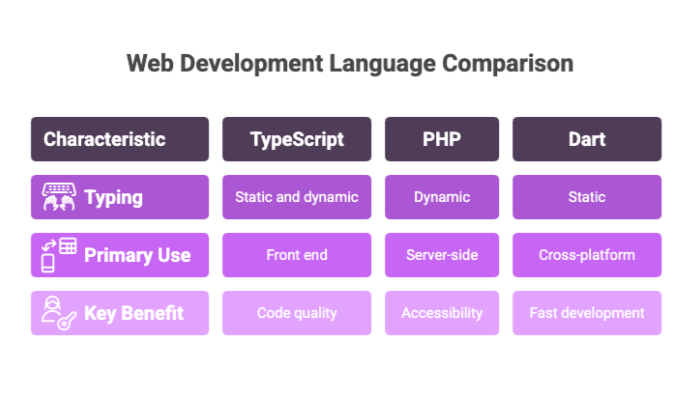

Programming Languages for Data Science
Data science demands powerful and versatile programming languages for complex data analysis, machine learning, and scientific computing. Languages like Python, R, and Julia are leading the way, each offering unique strengths for data scientists.These languages are crucial for extracting insights from data and building advanced analytical models. We will explore these languages to understand their roles and contributions in data science.
R
R is favored by statisticians and data miners for its robust capabilities in statistical computing and data visualization. R’s extensive libraries and tools make it particularly effective for data analysis across various domains.
Originating from the S programming language, R has a strong foundation in statistical and graphical analysis. R provides a powerful platform for data scientists performing comprehensive data analysis and visualization.
Julia
Julia is a high-level, high-performance language for scientific computing, data science, and machine learning. Its ability to perform complex computations quickly and efficiently makes it an ideal choice for applications that require high performance. Julia’s focus on mathematical computations and data analysis makes it valuable for data scientists and researchers.
Julia provides the speed and power needed for intensive scientific computing projects.
MATLAB
MATLAB, a matrix-based language, is primarily used by engineers and scientists for data analysis, algorithm development, and mathematical modeling. Its functionalities include matrix manipulations, data implementations, and function plotting, along with computation and visualization tools.
MATLAB’s applications in scientific computing and data science make it a versatile tool for professionals. For those looking to develop complex algorithms and analyze data, MATLAB offers a comprehensive platform for software applications and powerful tools.
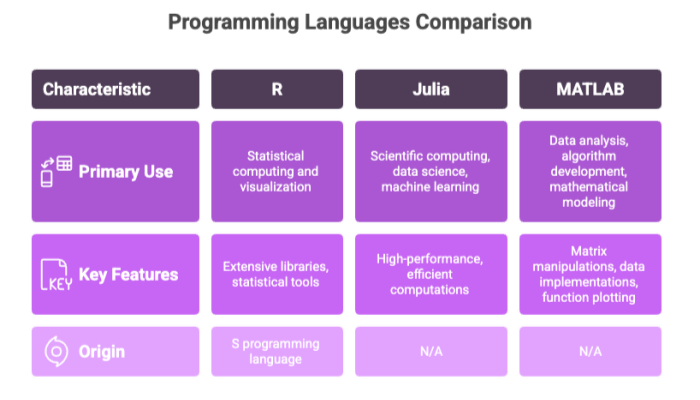

Specialized Programming Languages
Specialized programming languages cater to the specific needs of emerging technologies and applications. These languages focus on enhancing safety, performance, and efficiency in fields like artificial intelligence, blockchain, and IoT.
Solidity, Lua, and VHDL are at the forefront of these specialized applications, each offering unique capabilities. We will explore these languages and their roles in specialized software development.
Solidity
Solidity, a statically typed language, is designed specifically for writing smart contracts on the Ethereum blockchain. Its applications include decentralized applications (dApps), making it a crucial tool for blockchain developers.
Solidity provides the features and capabilities needed to build secure and efficient smart contracts. Its role in enabling decentralized applications highlights its importance in the blockchain ecosystem.
Lua
Lua, a lightweight, cross-platform language, is often integrated into game engines, and is also used in visual scripting systems, enabling developers to create game logic through graphical interfaces. This makes it a preferred choice for scripting in game development. Its use in the Löve2D framework demonstrates its accessibility and appeal to indie game developers and hobbyists.
The language’s cross-platform capabilities allow developers to use it across various systems, enhancing its versatility in game development and other applications. Lua offers a powerful and flexible scripting solution for creating immersive gaming experiences.
VHDL
VHDL (VHSIC Hardware Description Language) is used for designing and simulating electronic systems, particularly in FPGAs and ASICs. Its applications in embedded systems and hardware design make it a specialized tool for engineers and developers.
VHDL provides the precision needed to develop complex electronic systems for hardware description and simulation. Its role in embedded systems highlights its importance in the field of hardware development.
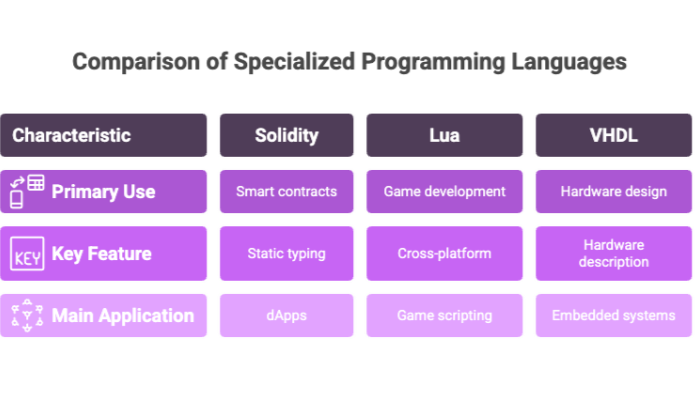

Scripting Languages
Scripting languages are crucial for automating tasks, integrating systems, and extending existing software to create software applications. Their flexibility and power make scripting languages invaluable for developers and system administrators. Scripting languages are also essential tools for network programming, automation, and network administration tasks.
Languages like Bash, PowerShell, and AWK are widely used for their scripting capabilities, each catering to different operating environments and tasks. We will explore these scripting languages and their unique features.
Bash
Bash is inherently linked to Unix/Linux systems, making it a native choice for users in those environments. Bash’s primary capabilities include scripting, automation, and system administration, making it a powerful tool for managing Unix/Linux systems effectively.
Bash offers a robust and versatile scripting solution for automating tasks and streamlining workflows. Its widespread use in Unix/Linux environments highlights its importance in system administration.
PowerShell
PowerShell is used for task automation and configuration management in Windows environments by system administrators and IT professionals. Its integration of command-line functionality with scripting allows for complex operational tasks to be managed efficiently.
The language’s capabilities in automating tasks and managing configurations make it a crucial tool for maintaining Windows systems. PowerShell provides the tools IT professionals need to streamline their workflows.
AWK
AWK is a scripting language focused on data manipulation and text processing. It is particularly used within Unix systems. AWK’s adeptness at handling text and data manipulation tasks makes it valuable for developers and system administrators.
For those working with large datasets and text files, AWK offers powerful capabilities for processing and analyzing data. Its role in Unix systems highlights its importance in data manipulation and text processing tasks.
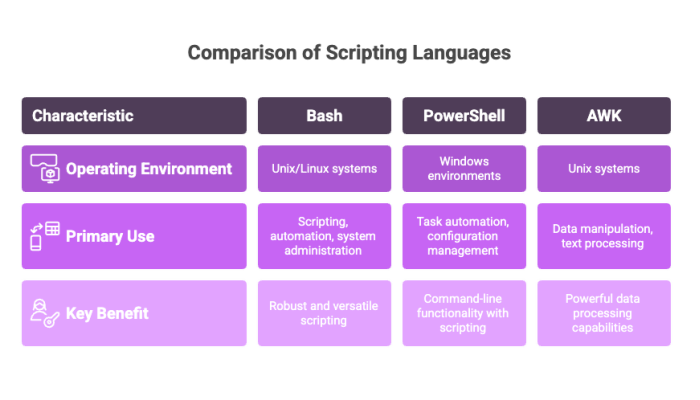

Summary
As we conclude our exploration of the top programming languages in 2025, it’s clear that the landscape of software development is both dynamic and diverse. From emerging languages like Crystal and Red to popular choices like Python and JavaScript, each language brings unique strengths and capabilities to the table.
Staying updated with these programming languages is crucial for developers looking to innovate and excel in their fields. This is especially important for professional developers aiming to maintain a competitive edge. Whether you’re building web applications, delving into data science, or developing complex software systems, the right programming language can significantly impact your success. Embrace the opportunities these languages offer, and continue to push the boundaries of what’s possible in software development.

Frequently Asked Questions
In this section, we address some of the most common questions related to technologies programming and the evolving landscape of programming languages. Understanding these frequently asked questions helps clarify key concepts about computer languages, programming skills, and the role of proprietary language versus open-source options.
We also touch upon the significance of machine language, the importance of the Java virtual machine in running code, and how object oriented capabilities influence modern software development.
This FAQ aims to provide concise and insightful answers to support both beginners and experienced developers in navigating the complexities of programming language design and application.
What are the emerging programming languages in 2025?
Emerging programming languages in 2025 include Crystal, Red, and Pony, each providing unique advantages for contemporary software development. These languages are gaining traction due to their innovative design and capabilities.
Why is Python so popular in 2025?
Python is popular in 2025 because of its readability, versatility, and comprehensive libraries that facilitate data science, web development, and machine learning. These features make it an invaluable tool for developers and data professionals alike.
What makes Rust a preferred choice for secure systems programming?
Rust's emphasis on safety, effective memory management, and concurrency support establish it as a leading choice for secure systems programming. Its design helps prevent common programming errors that can lead to vulnerabilities.
How does TypeScript enhance JavaScript for web development?
TypeScript enhances JavaScript by introducing optional static typing, facilitating error detection during development and ultimately improving code quality. This leads to more robust and maintainable web applications.
What are the key features of scripting languages like Bash and PowerShell?
Scripting languages like Bash and PowerShell are essential for automating tasks and integrating systems, with Bash primarily utilized in Unix/Linux environments and PowerShell serving Windows systems. Their ability to extend software functionality is a significant advantage in managing modern computing environments.

